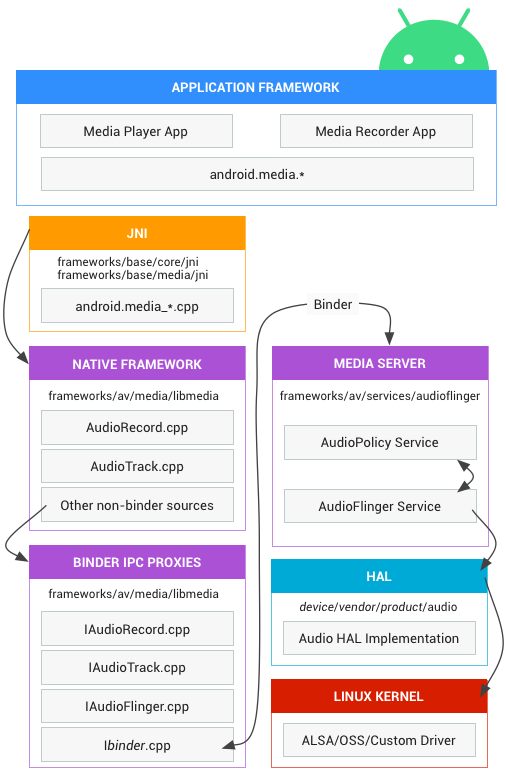
Hardware Abstraction Layer (HAL) ด้านเสียงของ Android จะเชื่อมต่อ API ของเฟรมเวิร์กเฉพาะเสียงระดับสูงใน android.media กับไดรเวอร์เสียงและฮาร์ดแวร์พื้นฐาน ส่วนนี้มีวิธีการติดตั้งใช้งานและเคล็ดลับในการ ปรับปรุงประสิทธิภาพ
สถาปัตยกรรมเสียงของ Android จะกำหนดวิธีติดตั้งใช้งานฟังก์ชันเสียงและ ชี้ไปยังซอร์สโค้ดที่เกี่ยวข้องซึ่งเกี่ยวข้องกับการติดตั้งใช้งาน

รูปที่ 1 สถาปัตยกรรมเสียงของ Android
- เฟรมเวิร์กแอปพลิเคชัน
- เฟรมเวิร์กของแอปพลิเคชันมีโค้ดของแอป ซึ่งใช้ API android.media เพื่อ โต้ตอบกับฮาร์ดแวร์เสียง ภายใน โค้ดนี้จะเรียกคลาส JNI glue ที่เกี่ยวข้อง เพื่อเข้าถึงโค้ดแบบเนทีฟที่โต้ตอบกับฮาร์ดแวร์เสียง
- JNI
-
โค้ด JNI ที่เชื่อมโยงกับการเรียกใช้ android.media จะเรียกใช้โค้ดเนทีฟระดับล่างเพื่อเข้าถึงฮาร์ดแวร์เสียง
JNI อยู่ใน
frameworks/base/core/jni/และframeworks/base/media/jni - เฟรมเวิร์กเนทีฟ
-
เฟรมเวิร์กเนทีฟมีแพ็กเกจ android.media ที่เทียบเท่ากับเนทีฟ โดยเรียกพร็อกซี Binder IPC เพื่อเข้าถึงบริการเฉพาะเสียงของเซิร์ฟเวอร์สื่อ
โค้ดเฟรมเวิร์กเนทีฟอยู่ใน
frameworks/av/media/libmedia - Binder IPC
-
พร็อกซี IPC ของ Binder ช่วยให้การสื่อสารข้ามขอบเขตของกระบวนการเป็นไปได้ พร็อกซีจะอยู่ใน
frameworks/av/media/libmediaและขึ้นต้นด้วยตัวอักษร "I" - เซิร์ฟเวอร์สื่อ
-
เซิร์ฟเวอร์สื่อมีบริการเสียง ซึ่งเป็นโค้ดจริงที่
โต้ตอบกับการติดตั้งใช้งาน HAL เซิร์ฟเวอร์สื่ออยู่ใน
frameworks/av/services/audioflinger - HAL
-
HAL กำหนดอินเทอร์เฟซมาตรฐานที่บริการเสียงเรียกใช้และที่คุณต้อง
ใช้เพื่อให้ฮาร์ดแวร์เสียงทำงานได้อย่างถูกต้อง ดูรายละเอียดเพิ่มเติมได้ที่อินเทอร์เฟซ
HAL เสียงและความคิดเห็นในไฟล์
*.halของไดเรกทอรีเวอร์ชัน HAL ที่เกี่ยวข้อง - ไดรเวอร์เคอร์เนล
-
ไดรเวอร์เสียงจะโต้ตอบกับฮาร์ดแวร์และการติดตั้งใช้งาน HAL คุณใช้ Advanced Linux Sound Architecture (ALSA), Open Sound System (OSS) หรือ
ไดรเวอร์ที่กำหนดเอง (HAL ไม่ขึ้นอยู่กับไดรเวอร์) ได้
หมายเหตุ: หากคุณใช้ ALSA เราขอแนะนำให้ใช้
external/tinyalsaสำหรับส่วนผู้ใช้ของไดรเวอร์เนื่องจาก การอนุญาตให้ใช้สิทธิที่เข้ากันได้ (ไลบรารีโหมดผู้ใช้มาตรฐานได้รับอนุญาตให้ใช้สิทธิ GPL) - เสียงดั้งเดิมของ Android ที่อิงตาม Open SL ES (ไม่แสดง)
- API นี้แสดงเป็นส่วนหนึ่งของ Android NDK และอยู่ในระดับสถาปัตยกรรมเดียวกันกับ android.media

